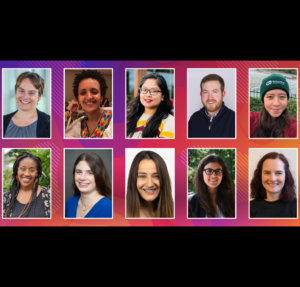Guest post by C Brandon Ogbunu.
2022 marks the return of the Population, Evolutionary, and Quantitative Genetics (PEQG) Conference, organized by the Genetics Society of America. Part of the meeting’s popularity stems from being one of the few conferences that brings together leading thinkers in subfields of genetics that don’t typically overlap, across a range of model organisms, united by methods and perspectives.
The meeting, which will take place June 7-10 in Pacific Grove, CA, at Asilomar Conference Grounds, is well-known for its structure: a combination of keynote addresses, awards, and short talks of various kinds. One of the key aspects of this structure is the session chairs: junior scientists who have established themselves as leaders in the various areas of population, evolutionary, and quantitative genetics. During the meeting, they each chair a session full of talks, and give 30-minute talks of their own during the final keynote session. The session chairs provide an opportunity for us to view the present and future of the field.
The 2022 session chairs promise to deliver on this tradition, featuring a tremendous lineup of thinkers who study problems as diverse as speciation genomics in plants to epistasis in human genomic data sets. This specific collection of speakers displays both breadth and depth, and so the chair keynote session promises to excite.
Below I will highlight these session chairs, commenting briefly on why I am personally so excited to hear about their work.
Nancy Chen
Evolutionary biology is, in part, a science that is defined by information from the past, but how do we use it to ask questions about contemporary evolution in natural populations? These are the questions of the “Pop Gen Chen Lab,” run by Nancy Chen. The lab addresses questions and utilizes tools to think about contemporary questions in short-term evolution, and how genetic variation is maintained in contemporary populations. In addition, the Chen lab makes use of the Florida Scrub Jay (a very compelling and well-studied system) to study population decline. The Chen lab has also generated an extremely useful list of resources on issues related to diversity, equity, and inclusion, and continues to be a leading voice on these matters in the population genetics community.
Lorin Crawford
Though he was raised in southern California, Lorin Crawford will come to PEQG from balmy New England, where his research program is sprawled out between Microsoft Research in Boston and Brown University (in Providence) where he is the RGSS Assistant Professor. It is difficult to fully capture the richness of his research program. He utilizes advanced statistical and machine learning approaches to directly address provocative questions in population genetics. For example, he has pioneered statistical tests that can be used to detect pairwise epistasis between mutations in large genomic data sets. In addition, his work dissects the architecture of complex traits. Lastly, Crawford has recently begun to explore the ethics of genomics evolution. Recent work in this realm has challenged notions that are used to characterize populations, such as “transethnic.”
Rafael Guerrero
From North Carolina comes Rafael Guerrero, an Assistant Professor at North Carolina State University. He runs a program that develops tools that have already transformed our approach to classical questions in population and evolutionary genetics and explores the questions directly relevant to practical problems in biomedicine and bioengineering. In the former sense, Guerrero has done groundbreaking work on chromosome evolution and hybrid incompatibilities in light of speciation genetics, both central and critical questions in evolutionary genetics. In the latter sense, Guerrero’s mastery of theoretical tools has allowed him to explore areas such as the genomics of adverse pregnancy outcomes, and the physiological determinants of epistatic interactions as they manifest in the evolution of antibiotic resistance.
Priya Moorjani
The Genetics Society of America is well-known for its commitment to model systems research and has long championed its importance. But it also recognizes the importance of human genetics and evolutionary biology, not only because we…are humans, but also because human evolution is an amazing problem space for cutting-edge questions in evolutionary and population genetics. Few scientists are doing more exciting work in this area than Priya Moorjani. Moorjani uses statistical and computational approaches to understand the role of genetic variation in human evolution, demography, and mapping disease risk alleles at the University of California, Berkeley. Moorjani has also investigated fundamental questions in primate evolution, such as the proper estimation of mutation rates. Moorjani has mastered the art of transforming a species that we all care about–Homo sapiens–into a model system in evolutionary genetics.
Rori Rohlfs
As Assistant Professor at San Francisco State University, Rori Rohlfs won’t need to travel especially far to get to Asilomar, but everything with Rori is an intellectual expedition. Rohlfs runs an exciting program that has examined everything from the evolution of gene regulation to critical statistical questions relevant to genomic testing and forensics. Rohlfs has accomplished this while also being a widely recognized teacher and mentor. Lastly, Rohlfs was one of the corresponding authors on an outstanding 2019 study published in GENETICS that analyzed early population genetics literature and identified the many women that were often denied proper credit for their participation.
Daniel Runcie
When I teach evolution, I often discuss a 2018 study that estimated the biomass of living things on earth, organized by different taxa. Though I do not study plants, I often use it to explain that when it comes to life on earth, plant life is the heavyweight champion. Daniel Runcie runs a thrilling research program that attempts to understand how and why plants are so successful, and especially questions related to genetic variation and phenotypic plasticity. The Runcie lab attempts to identify pathways and networks related to how plants respond to a dynamic environment. One of the reasons that plants have been so successful is their ability to respond to change. The Runcie lab uses a host of tools—statistical, network, and ecophysiological—to understand these questions.
Learn more about the #PEQG22 Session Chairs, as well as Invited Speakers, on the conference website. Registration is open now.

About the author
C. Brandon Ogbunu is Assistant Professor in the Department of Ecology and Evolutionary Biology at Yale University and one of the organizers of the 2022 Population, Evolutionary, and Quantitative Genetics Conference.













